The interesting thing about the "Gwandongdo" map is that the island of Ulleungdo is labeled with both "Ulleungdo" (鬱陵島 - 울릉도) and "Usando" (干山島 - 간산도), which suggests that the two islands were right next to each other. [干山島 was a misspelling of 于山島.] That is confirmed by the Ulleungdo map, which was in the same book (Book 7) of the atlas and shows Usando as just a small neighboring island off Ulleungdo's east shore. The small island was labeled as "所謂 干山島" (소위 간산도), which means "the so-called Usando."
Notice that the Ulleungdo map has the same spelling error (干山島) for "Usando" (于山島) as the Gangwon Province map. Notice also that in addition to Usando, the Ulleungdo map shows five small islands off Ulleungdo's southern shore, which was a common feature of Korea's Ulleungdo maps.
In the geography section of the "Annals of King Sejong" (1454), Ulleungdo was mentioned in the section describing Uljin-hyeon (蔚珍縣) as follows:
于山武陵二島在縣正東海中二島相去不遠 風日淸明則可望見Korea uses the above passage to claim that Usan was "Dokdo" (Liancourt Rocks), and that the distance being talked about was the distance between Dokdo and Ulleungdo. ["Muleung" was an alternate spelling for Ulleungdo.] However, Japan claims that the distance was a referrence to the distance between Uljin-hyeon (on the mainland) and the two islands. The Gangwon Province map below, which shows the two islands grouped as just one island, supports the Japanese claim that the passage was talking about the distance from the Korean mainland to the two islands, not the distance between the two island.
The two islands of Usan (于山) and Muleung (武陵) are in the sea due east of this hyeon. The distance to the two islands is close enough that they can be seen on a clear day when the wind is blowing.
Both the "Gwandongdo" map and the Ulleungdo map came with attached notes, which are also shown below. The "Gwandongdo" map notes mentioned such things as the population of the region and the number of fields and paddies. The Ulleungdo map notes gave the size of the island and listed the flora and fauna found there.
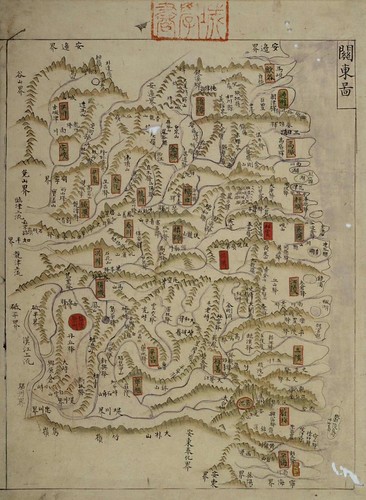
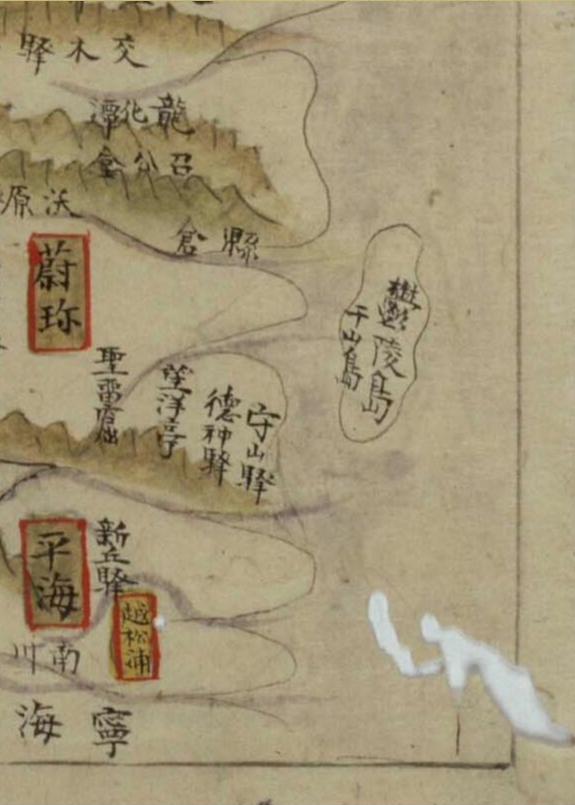

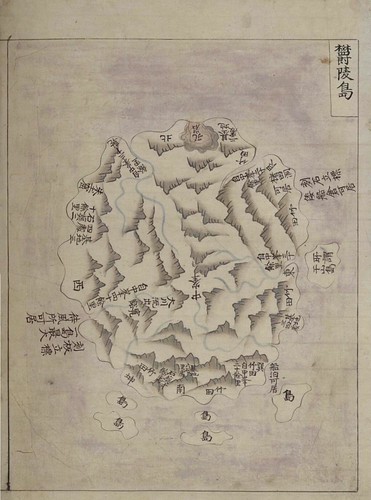
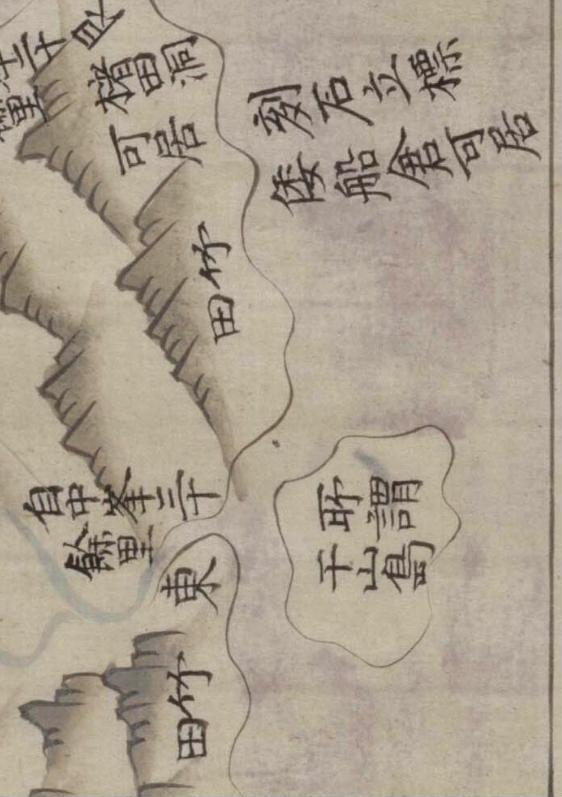
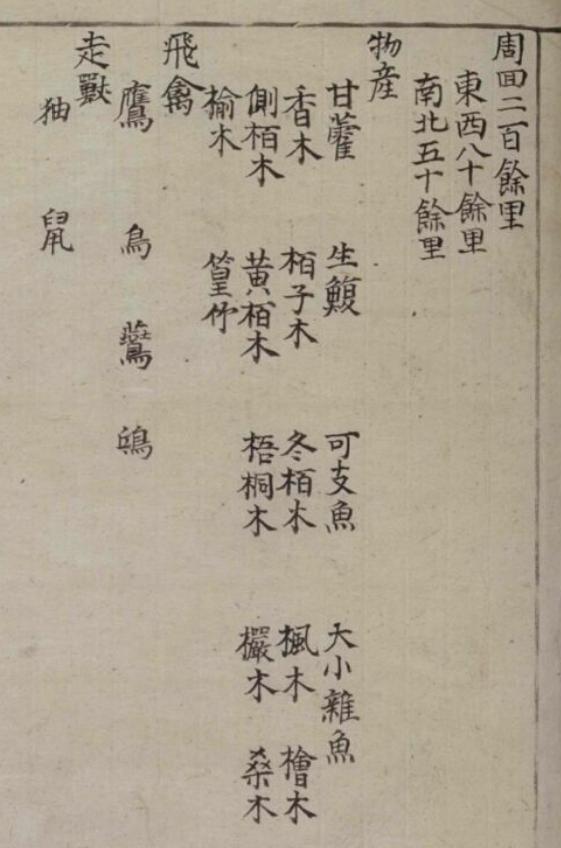
1740.李瀷「鬱陵島」
ReplyDelete鬱陵島在東海中 一名于山 遠可七八百里 自江陵三陟等地 登高望之 三峯縹緲隱見.
Im not sure it is correct or not of my briefly translation below.plz someone coorect my poor translatons.regards
Ulluengdo in the east of the ocean, allas Usan, distance could be7-800里. From 江陵or三陟 and so on,It can be seen from the high altitude that Three peak is slightly in the cloud?
sry for double post.It is better to post more text above.
ReplyDelete鬱陵島在東海中 一名于山 遠可七八百里 自江陵三陟等地 登高望之 三峯縹緲隱見. 新羅智證王十二年 其人 持强不服 何瑟羅州軍主異斯夫 以木獅威服 何瑟羅卽今江陵也. 高麗初來獻方物 毅宗十一年遣金柔立 往審羽陵島 從山頂東行 至海一萬餘步 西行一萬三千餘步 南行萬五千步 北行八千步 有村落基址七所 有石佛鐵鐘石塔 地多岩石 不可居 然則是時已成空地矣. 本朝適民多入居 太宗世宗時 皆往搜盡俘還之. 芝峰類說云 鬱陵島壬辰後被倭焚掠 無復人烟 近聞倭占據礒竹島 或謂礒竹卽鬱陵也. 倭以漁氓安龍福犯越事來爭 以芝峰類說及禮曹回答 有貴界竹島之語爲證. 朝廷遣武臣張漢相 往審之南北七十里 東西六十里 木有冬栢紫檀側栢黃蘗槐椵桑楡 無桃李松橡 禽獸有烏鵲苗鼠 水族有嘉支魚 穴居巖磧 無麟有尾魚身四足 而後足甚短 陸不能善走 水行如飛 聲如嬰兒 脂可以燃燈云. 於是朝廷費辭往復彌縫乃止
gtomr,
ReplyDelete鬱陵島在東海中 一名于山 遠可七八百里 自江陵三陟等地 登高望之 三峯縹緲隱見.
Ulleungdo is in the sea due east. It is also called "Usan." The distance is about 700 or 800 ri. If you climb to a high place in the Gangneung (江陵)/Samcheok (三陟) area and look out, you can catch glimpses of its three peaks shimmering in the distance.
That is an interesting passage. Where did you find it? And do you have a link to the original copy?
GTOMR,
ReplyDelete“自江陵三陟等地 登高望之 三峯縹緲隱見"
Good job ! So, even 李瀷 thought it is the description of Ulleundo from mainland. This is a great finding since I was not sure where the high place in the passage of the yesterday's news.
1629~1703年 - 朴世堂「西溪宗宅古文書 西溪雑録 鬱陵島」
"欝陵島 新羅史曰于山国島名欝陵地名百里 欝陵或曰武稜亦曰羽稜登高望之三峰及業掌空 而南峯梢低日初出時風恬浪静即衆峯攅青岩壑呈露沙汀樹木 歴々可●(見?)"
Gerry,
Did you read the yesterdays news on Choson Ilbo?
‘우산도’는 역시 독도였다
해양수산개발원 유미림 박사, 조선후기 박세당이 쓴 자료 발굴
“울릉도에서 정상 안오르면 우산도가 보이지 않아”…
‘우산도가 울릉도’라는 日 주장 뒤집어
http://news.chosun.com/site/data/html_dir/2007/12/04/2007120400027.html
It should be more pages since there is no "不因海氣極淸朗, 不登最高頂, 則不可見" part on the page in the picture. (Why do they omit such a crucial part?) But as far as I can read, it clearly tells 于山国島's name is 鬱陵, or the name of the island in 于山国 is 鬱陵. There is no mention of 于山(Usan), or another island at all.
Kaneganese,
ReplyDeleteYes, I saw that. I think it is just another example of a Korean scholar letting his imagination get the better of him.
The first part of text looks like one of the travel descriptions of Ulleungdo that is found in the "Wayurok" (臥遊錄), which was a collection of travel descriptions written sometime during the Joseon period. You can see the first page HERE, which looks the same as the first page in the newspaper article. The you can click on "다음" to see the next two pages. You can find the quote from the newspaper article on the third page.
You can find the text HERE, which is copied below.(Look in the third paragraph for the relevant text.):
[주:新羅史曰于山國島名鬱陵]地誌鬱陵或曰武陵亦曰羽陵登高望之三峰岌嶪撑空而南峰稍低日初出時風恬浪靜則衆峰攢靑岩壑呈露沙汀樹木歷歷可指新羅智證王聞于山國負險不服命伊湌異斯夫爲阿瑟羅州軍主阿瑟羅江陵往討之斯夫以爲于山愚頑負險難以力服易以計下乃多造木獅子分載戰艦誑之曰伱不急下當放此獸摶噬之國人恐懼來降及高麗太祖十三年島人使白吉土豆獻方物毅宗聞羽陵地肥廣可立州縣遣溟州道監倉金柔立往視回啓曰島中有大山從山頂向東行至海濱一萬三千餘步向南行一萬五千步向北行八千餘步有村落基址七所或有石佛鐵鍾石塔多生柴胡藁本石南草土多嵓石民不可
居遂寢厥後崔忠獻議以武陵土壤膏沃多珍木海錯遣使視之有村墟屋址宛然於是移東郡民實之使還多以海中珍怪之物來獻其後屢爲風濤所蕩覆舟人多物故乃還其民及我朝太宗大王時聞流民迯入者甚多命三陟人金麟兩爲按撫使刷出空其地麟兩言島中土地沃腴竹大如杠鼠大如猫桃核大於升凡物稱是云世宗大王二十年遣縣人南灝率數百人往搜逋民盡俘金九等七十餘人出來成宗大王二年有告別有三峰島者乃遣朴宗元往覔之因風濤不得泊而還同行一船泊羽陵島只取大竹大鰒魚以歸啓曰島中無人矣嘗遇一僧自稱壬辰之亂俘入日本丙午隨倭船至鬱陵島島
有大山三峰尤峻發島三面皆壁立萬仞南邊稍開豁然亂山若犬牙撑列水底舟道極險狹難入登岸則白沙平鋪長松列植山開望濶而江水流出緣江行十餘里則篔簹作藪不見天日大君梁柱小不减椽杠又穿藪行十餘里則有竹林其脩大若篔簹竹林旣窮而原野夷曠有村居墟落山多珍木藥草倭方伐竹採藥留渠守船鄰船適有同俘七人夜與相語天將曉發船以來日纔晡已到寧海地面云盖二島去此不甚遠一颿風可至于山島勢卑不因海氣極淸朗不登最高頂則不可見鬱陵稍峻風浪息則尋常可見麋鹿態獐往往越海出來朝日纔高三丈則島中黃雀群飛來接竹邊串[주:島中竹實特時漂出形如大慱暴海女拾之爲雜佩篔簹及竹亦或漂出一節有數尺者宜箭筒比多有之]
By the way, Kaneganese, there is another description of Ulleungdo from the same volume of the text HERE. Just click "다음" to go to the second page.
ReplyDeleteAnd you can find the text HERE," which is copied below:
蔚陵島說
鵝溪蔚陵島在東海之中距海濱不知其幾百里也每秋冬之交陰曀捲盡海氣澄朗則自嶺東望之如一后蒼烟撗抹於水天之間獨眞珠府與此島最爲相對故行人之登召公臺者或見其林木岡巒之狀了了然可辨以此知不甚遠也箕城人嘗言麋鹿蘆竹往往浮出於沙渚之間禽鳥之不知名者亦翩翩渡海而來及至海濱垂趐自墮爲光童所捕者數矣漁人舟子或凜到島傍見萊根蔬葉隨水出來而四面皆蒼岩鐵壁只有一洞門可捫蘿而入慮有防守者彷徨躅躑不敢近而回棹者有之居是島者未知爲何許人或疑其避役逃罪之輩自相婚嫁漸至繁盛或疑其獠蠻之種據有是島非自近始或疑其果有之
則豈無一番舟楫之往來豈無一物可交貨有無於他境乎疑者不一無所歸宿終置是島於茫昧恍惚無何有之鄕豈退之所謂桃源之說誠荒唐者歟噫仙神之說尙矣所謂蓬萊方丈瀛洲未知果眞有而崑崙玄圃見之者抑誰歟如使神仙不有則已有之則是島也妥知蓬萊崑崙之一而異人仙客之所在耶一幅布帆便風高掛則不過一晝夜之頃可以致身其間而世之羣疑衆惑從此可破旣不得此則令人徒費引領東望而空入於夢想吟咏之中悲夫
Thank you, Gerry.
ReplyDelete"不因海氣極淸朗不登最高頂則不可見鬱陵稍"
Now I understood why they didn't show the page. There was object for the verb "見 (look)" and it is "鬱陵梢(A treetop on Ulleundo)". That means "If the weather of the sea is not extremely clear, or don't climb on the top of the mountain, we cannot see the treetop of Ullendo." It is apparently talking about Ulleundo, not Usando ( or Ulleundo and Usando) from mainland of Choson.
What a shame...
Thank you, GTOMR and Kaneganese.
ReplyDeleteBy the way, how would you translate the following?
寧海地面云盖二島去此不甚遠一颿風可至于山島
Isn't it saying, "the sea was calm and clouds covered the two islands, which were close enough that Usando could be reached with one gust of wind"?
If it is saying that clouds covered the two islands, then that means that the two islands were next to each other. And if one gust of wind could get you to Usando, then that would mean Usando was a nearby neighboring island. Am I interpreting it wrong?
"已到寧海地面云盖二島去此不甚遠一颿風可至于山島"
ReplyDelete"I reached to the calm sea and the land. It is said that perhaps two islands are not far, and with a good wind it can reach Usando. "
This is how I read. I hope Yabutarou gives me an advice. 盖(=蓋) does have a meaning of "cover", but I think it means "perhaps" in this sentence. And I don't know what "颿" means. it's not in my dictionaly. I guess it must be a "gale" or something like that.
This comment has been removed by the author.
ReplyDelete寧海(ninghai?)is the place of name on the east of Korean peninsula ,south of 三陟.
ReplyDeleteSee the maps.
Wow !!!
ReplyDeleteThank you, GTOMR. (Or am I the only one who didn't know this?) In that case, it's definately talking about today's Ulleundo, not Takeshima/Liancourt Rocks/Dokdo and it means it can be seen from mainland of Choson, not from Ulleundo.
"已到寧海地面云盖二島去此不甚遠一颿風可至于山島勢卑不因海氣極淸朗不登最高頂則不可見鬱陵稍"
"I reached to the land of 寧海 and it is said that perhaps two islands are not far (from here=寧海 ), and with a good wind it can reach Usando. (The island is) not huge, thus if the weather of the sea is not extremely clear, or don't climb on the top of the mountain, we cannot see the treetop of Ullendo."
Finally, it totally makes sence.
Kaneganese,
ReplyDeleteNo, you are not the only one who did not know it. I didn't recognize it, either, even though I had seen it before. It just did not click. In fact, a lot of things are not clicking these days.
Thanks, gtomr. The Korean pronunciation of 寧海 is "Yeonghae."
Actually, I still do not understand the sentence in question. It seems somewhat strange. For example, why was 地面 used in this context? Maybe it will make more sense to me tomorrow.
It looks like Hanmaumy got a images of the documents and translated it totally wrong.
ReplyDeletehttp://hanmaum.web-bi.net/zbxe/447
倭方伐竹採藥留渠守船鄰船適有同俘七人夜與相語天將曉發船以來日纔晡已到寧海地面云盖二島去此不甚遠一颿風可至于山島勢卑不因海氣極淸朗不登最高頂則不可見
왜적은 대나무를 베고 약초를 채취하여 거수선에 두고 인근의 배로 갔다. 밤에 함께 있던 포로 7명과 서로 이야기 해보니 새벽 동틀무렵 배를 출발시켜 내일 신시(오후 3~5시)가 되면 겨우 영해땅에 도착할 것이라고 한다. 대개 두 섬은 그 거리가 멀지 않아 한번 바람을 타면 도착할 수 있다. 우산도는 지세가 낮아 날씨가 매우 맑지 않거나 최고 정상에 오르지 않으면, 보이지 않는다.
He cut sentence at the wrong point. In Chinese normally put object after the verb, not before. Thus it should be 云盖二島去此不甚遠/一颿風可至于山島/勢卑不因海氣極淸朗不登最高頂則不可見鬱陵稍/峻風浪息則尋常可見麋鹿態獐...
Not 云盖二島去此不甚遠一颿風可至/于山島勢卑不因海氣極淸朗不登最高頂則不可見/鬱陵稍峻風浪息則尋常可見麋鹿態獐...
Look, he reads the verb "見(=look)" and object "麋鹿態獐... "correctly in the next sentence. It means he did it (misreading) intentionally.
2007.12.05 19:31 한마음 鬱陵稍峻風浪息則尋常可見麋鹿態獐往往越海出來朝日纔高三丈則島中黃雀群飛來接竹邊串
울릉도는 높고 낮은 풍랑이 잦아들면 고라니와 사슴, 노루가 이따금 나오는 모습을 바다를 건너서 대수롭지 않게 볼 수 있다. 아침해가 겨우 3장일때 섬 안의 황작 무리가 날아와 죽변곶에 모여 든다.
Why Korean like him keep making this kind of distortion? But honestly, he gave us a very important documents which actually support Japanese claim. We have to thank to him.
This comment has been removed by the author.
ReplyDeletePlease advise the indents the text below;
ReplyDelete有同俘七人 夜與相語天將 曉發船以來日纔晡 已到寧海地 面云盖二島去此不甚遠 一颿風可至于山 島勢卑不因海氣極淸朗 不登最高頂 則不可見鬱陵 稍峻風浪息則尋常可見麋鹿態獐往往越海出來 朝日纔高三丈 則島中黃雀群飛來接竹邊串
1:于山 or于山島?
2:鬱陵と欝陵稍
朝鮮日報の記事についての私の見解をYahoo!掲示板に書いたのでよかったら参考にしてください。大変な時間がかかってしまいました。。http://messages.yahoo.co.jp/bbs?.mm=GN&action=m&board=1835396&tid=cddeg&sid=1835396&mid=16029
ReplyDelete続きhttp://post.messages.yahoo.co.jp/bbs?.mm=GN&action=m&board=1835396&tid=cddeg&sid=1835396&mid=16030&n=1
ReplyDeleteThanks yabutarou
ReplyDelete(^^)
Yabutarouさん
ReplyDeleteありがとうございました。大変参考になります。長かったので、要点だけを訳そうと思ったのですが、思ったより長くなってしまいました。婉曲的ないい方は私の英語力では適切に訳せないので、かなり意味合いが違うかもしれませんが、何かお気づきでしたらお知らせ下さい。
This is the point of Yabutarou's version of translation. (Note; he says he's not 100% sure since he is not a professilnal.)
”到寧海地面云盖二島去此不甚遠(寧海地面に到りて云う盖(がい)二島は此(ここ)を去ること甚だしくは遠からず)
"Arriving at 寧海 and said, "two islands are not far from here.""
Meaning,The distance between 寧海(the name of the place on mainland of Choson.) and two islands are not far."
If "到寧海地面云盖二島去此不甚遠" is talking about the relation ship between mainland of Choson and the two islands, then the latter sentence "于山島勢卑 something something..." is considered to be talking about the relationship between the penninsula and the two islands. Moreover, the last sentence "島中黄雀群飛來接竹邊串(竹邊串=the name of the place on penninsula.)" apparantly mentions about the relationship between penninsula and the two islands. Thus, ”于山島勢卑不因海氣極淸朗不登最高頂則不可見鬱陵稍峻風浪息則尋常可見” means that Usando and Ulleundo can be seen from Choson penninsula. If the author want to say that Usando can be seen from Uleundo, it is illogical that there is no mention of "from Ulleundo" in the sentence. It doesn't make sence. This is the same translation with Prof, Shimojou as a result.
There are some more documents in it says that Usand can be seen from Choson mainland.
To Yabutarou,
ReplyDeleteThank u so much for your post and translation!
By the way,please advise 海東繹史 and 眉叟記言,are there any Chinese text or only korean writing text in the link?
To kaneganese,
I guess, the broadcasting of new doccu西溪雜錄 on 4th of Dec, is just a domestic counter propaganda to deceive Korean issue of much more crucial evidence 大于島-小于島 maps.
There are the reason they didn't upload the essential text part in newspaper. For them,it is disadvantage that propaganda become weak effect on inside Korea if suddenly disclosured of twist translation.
Talkiing about Korean Propaganda on Liancour Rocks, they have much more strategy and organized,than we think.
pontaさん・Kaneganeseさん・GTOMRさん
ReplyDeleteどういたしまして。
Kaneganese さん
去此の此が寧海を指しているので于山島を見たのは鬱陵島からではなくて寧海・朝鮮半島からであるという点が重要です。
This is the same translation with Prof, Shimojou as a result.
これはあくまで下條教授の世宗実録地理誌の解釈と同じということであって下條教授がこの文を翻訳したわけではないので誤解を招くかも。。
あと省略されたリンク先がかなり重要なんですよ。。。
GTOMRさん
By the way,please advise 海東繹史 and 眉叟記言,are there any Chinese text or only korean writing text in the link?
リンク先のぺージにあるリンクをあれこれいじってみれば見つかるかもしれません。海東繹史の文の最初のぺージの画像は見つかりましたが面倒なのでその先はあきらめました。
Gerry & all,
ReplyDeleteHi, it's been quite a while since I posted last on Matt's site. Congratulations on your new site. I can see a lot of work has gone into this.
Kaneganese,
どなたからも返答がないようなので。
"颿" is the old form of "帆."
Hi Two Cents,
ReplyDeleteYes, it has been a while. I guess you have been busy with other things. Anyway, it is good to hear from you.
Gerry,
ReplyDeleteThere is correcion in my translation above.
The most important point Yabutarou consider is "此" in the sentence "到寧海地面云盖二島去此不甚遠". Since it (此=this, here)" mean 寧海, then it makes it was from 寧海 on Choson panninsula that Usando was seen, not from Ulleundo.
And another thing he want us to make sure is his translation of this new document happened to be same with Prof.Shimojou's translation of 世宗実録地理誌.
And he thinks the links he wrote are very important and I should have added in transltation. (I'm really tired today, so I 'll check it tomorrow if I can translate them or not.)
I hope I did it right this time.
Yabutarouさん
こんな感じでしょうか?失礼しました。明日時間のあるときにもう一度見直します。
Hi ! Two Cents !
Thank you for the meaning of "颿".
Where have you been? Can you see how far we came from the last Takeshima day and Gerry's article? We have very interesting people like GTOMR and Yabutarou (plus pacifist and ponta as always) now and recently the things are getting really exciting. We may be able to prove 石島 in 1900 Imperial Ordinance is Kwanundo or catchall name for 5 small rocky islets around Ulleundo. Who knows?
Anyway, I hope you visit often since you are really talented. (And if you find any mistakes, please let me know.) .
kaneganese,
ReplyDeleteSorry, I've been out of touch. I was in a bit of a mentally low state. I'm recovered now, so I'll try to contribute the best I can.
You have all done a truly great job of compiling all these information and maps. It's now so obvious how all documents cite previous documents (showing the diligence of Chosun-period bureaucrats), and that the "not far" description refers to the distance of the two islands from the shores of the Korean peninsula, and not referenced from Ulleungdo. Why else would the author(s) climb high and look out to Ullengdo or write that the the islands are not far away before setting sail ?
Two Cents,
ReplyDeleteI'm glad to hear you got well now. I think highly of your knowledge of 漢文, English and history especially, so if you can comment often, it will be a great help for everyone. (But you should avoid getting involved in helpless and stressful debating, you know what I mean ? (Actually, I'm avoiding it now, since I'm too busy.)
Yabutarouさん
ReplyDeleteリンク先読みました。朝鮮の人々にとって、半島において山に登って(晴天時)に鬱陵于山が見えるというのは当然の認識だったことが伺えます。于山島=竹嶼であるならば鬱陵島の陰に隠れて見えるはずがないのでありえない、と言う論理が通用しないことが分かります。
ところで、Yahoo掲示板でのご意見を私が英訳してGerryに手直ししてもらって、本サイトでも投稿するというのは如何でしょうか?(と言っても実は今引っ越し大作戦の真っ最中なので、今日明日、というわけには行かないのですが...)
Thank you, Kaneganese.
ReplyDeleteI want to try to translate the whole thing, hoping that it will give it some context. This text is especially confusing for me, and I want to study it for a while. It made me realize that I still do not know how to read this stuff very well. I have a book on how to read this old Chinese writing, but it will take me a while to get through it, and it is only a beginning level book.
Anyway, what is the relationship with the 世宗実録地理誌? Do you mean that parts of this text come from that?
So, you are moving to a new place? Or have you already moved and trying to get settled in? Anyway, I think we can take our time with this.
Is this your final translation of that one part?
"已到寧海地面云盖二島去此不甚遠一颿風可至于山島勢卑不因海氣極淸朗不登最高頂則不可見鬱陵稍"
"I reached to the land of 寧海 and it is said that perhaps two islands are not far (from here=寧海 ), and with a good wind it can reach Usando. (The island is) not huge, thus if the weather of the sea is not extremely clear, or don't climb on the top of the mountain, we cannot see the treetop of Ullendo."
Gerry wrote,
ReplyDelete"what is the relationship with the 世宗実録地理誌? Do you mean that parts of this text come from that?"
No, he meant that even though the sentence didn't directly referred from 世宗実録地理誌, his translation of this documents, the discription of the distance is between mainland and two islands, is same with the Prof,Shimojou's translation of 世宗実録地理誌 afterall. Prof. Shimojou claims that distance which is mentioned in "于山、武陵二島、在縣正東海中、二島相去不遠、風日清明、則可望見" from "世宗実録地理誌 " is distance between mainland and two islands,
"Is this your final translation of that one part?"
I need to make sure Yabutarou a few points we differ. Actually, I asked Yabutarou, if I can translate all of what he wrote and post it for him. There are some more important part other than the translation of this one sentence. For example, the three documents he linked wrote clearly that Ulleundo can be seen from mainland. I think for a long time since 1400's, it has been natural for Choson people to say that Ulleundo can be seen from mainland, but Korean suddenly changed their perception in order to justify their illegal occupation of Takeshima/Liancourt Rocks. I think it is natural for them to check the distance before sail to Ulleundo as Two Cents said.
Anyway, it's a good idea to translate whole documents. I wish I could help you, but the translating whole documents are bit too much for me, since there are many words I don't know and I'm busy right now. ( We are going to move next week, but we are packing and preparing the house( waxing, rush protection and so on.) to reduce chemicals before we move in and protect the house at the same time. )
Yabutarouさん
私の訳のうち"已""盖""鬱陵稍"が微妙に違うようなので、確認します。
"已"は、"私"とは訳さない。
"盖"は二島にかかる強調の言葉で特に意味はない。
"鬱陵稍"は、”不可見”の目的語でよいのでしょうか。それとも、"稍"は次の文にかかるのでしょうか。
それと、"一颿風可"は、"帆がよい風をうければ"、とでも訳せばよいでしょうか。
細かいことで、申し訳ありません。
The discription View from East coast of peninsula to ulluengdo with crowdy or mountains.
ReplyDelete1432.世宗実録 地理志 江原道襄陽縣于山、武陵二島、在県正東海中、二島相去不遠、風日清明、則可望見、新羅時、称于山国、一云 鬱陵島、地方百里....
1445.世宗 108권, 27년( 1445 을축 / 명 정통(正統) 10년) 6월 12일 갑인 1번째기사
○甲寅/諭江原道監司: 內贍寺令史金滿告: “襄陽府人金延奇嘗言: ‘東距府海路百餘里之地, 有蓼島。’” 今更詳問延奇等, 備悉以聞。
1445.08.17
諭江原道監司:世傳東海中有蓼島久矣, 且云見其山形者亦多, 予再遣官, 求之不得。 今甲士崔雲渚言: “嘗登三陟烽火峴望見。 其後因往茂陵, 亦望此島。” 南薈言: “年前在洞山縣亭上, 望見海中有山, 質諸其縣吏, 答曰: ‘此山, 自古有之。’ 使其吏終日候之, 曰: ‘非雲氣, 實山也。’” 予謂此島, 海中必有之, 然島山平微, 海浪連天, 在岸者未得詳見.....
1445.世宗 109권, 27년( 1445 을축 / 명 정통(正統) 10년) 8월 17일 무오 1번째기사
午/權孟孫啓: “前司直南薈與臣言‘蓼島在三陟府海中, 望見之。’今若遣薈, 則庶或可得。”時薈丁憂在家, 特命起復, 賜衣一襲笠靴遣之
1452.高麗史 地理誌 卷五十八 蔚珍県
于山、武陵二島、在縣正東海中、二島相去不遠、風日清明、則可望見、新羅時、称于山国、一云鬱陵島、 地方百里
1454.世宗実録 地理志 江原道襄陽縣
于山、武陵二島、在縣正東海中、二島相去不遠、風日清明、則可望見、新羅時、称于山国、一云鬱陵島、 地方百里、恃険不服
1531.『新增東國輿地勝覧』巻之四十五、蔚珍縣 于山島 鬱陵島
蔚珍縣 于山島欝陵島 一云武陵一云羽陵 二島在縣正東海中 三峰岌業撑空 南峯稍卑 風日清明 則峯頭樹木及山根沙渚 歴歴可見 風便則二日可到 一説于山欝陵本一島 地方百里
1696.
朝鮮国礼曹参判李番、奉復日本国対馬大守平公閣下、槎使鼎来、恵□随至、良用慰荷弊邦江原道蔚珍県有属島、 名曰蔚陵、在本県東海中、而風濤危険、船路無便、故中年移其民空其地、而時遣公差往来捜検矣、本島巒樹木、自陸地歴々望見、而凡其山川紆曲、地形濶狭、 民居遺址、土物所産、倶戴於我国輿地勝覧書
The description on the Korean historical map from 1600-1900A.D
”于山島在三陟之東 鬱陵島在平海之東 六日程地”(Yabatarou's post)
臥遊録,鬱陵島説
(Gerry's post)
玉川先生文集卷之七 雜著 關東錄 戊子四月佐幕時(Yabatarou's post)
1740. 李 瀷「星湖僿說 鬱陵島條(Already posted)
Thank you, Kaneganese.
ReplyDeleteDon't worry about the translation. I will work on it alone. It will be a learning experience for me. Maybe, you can check for mistakes after I finish.
Good luck with the move.
おとといヤフー掲示板に書いた投稿に問題点が見つかったのでこれを修正する文章を書きました。私はこれをヤフー掲示板に投稿しようと思いましたが大変難解な上にどうでもいい内容のように思えてきたのでヤフーには投稿せずに代わりにここに投稿します。
ReplyDelete修正前 「去此」の「此」は寧海であり朝鮮半島である。
修正後 「去此」の「此」は寧海ではないかもしれないが朝鮮半島である。
ーーーーーーーーーーーーーーーーーーーー
昨日のNo.16029の投稿の朝鮮日報の「西溪雑録」・「臥遊録」の解釈についてさらに検討を加えた結果解釈を変更すべきとの結論に達しましたので報告させていただきます。
まず「臥遊録」の記述を紹介します。
嘗遇一僧自稱壬辰之亂俘入日本丙午隨倭船至鬱陵島島有大山三峰尤峻發島三面皆壁立萬仞南邊稍開豁然亂山若犬牙撑列水底舟道極險狹難入登岸則白沙平鋪長松列植山開望濶而江水流出緣江行十餘里則篔簹作藪不見天日大君梁柱小不减椽杠又穿藪行十餘里則有竹林其脩大若篔簹竹林旣窮而原野夷曠有村居墟落山多珍木藥草倭方伐竹採藥留渠守船鄰船適有同俘七人夜與相語天將曉發船以來日纔晡已到寧海地面云
蓋二島去此不甚遠一颿風可至于山島勢卑不因海氣極淸朗不登最高頂則不可見鬱陵稍峻風浪息則尋常可見麋鹿熊獐往往越海出來朝日纔高三丈則島中黄雀群飛來接竹邊串
かつて一人の僧侶に出会ったが(彼は)壬辰之乱の時に日本の捕虜となって日本の船に伴われて鬱陵島に行ったと自称して島には大きな山が三つあり(中略・鬱陵島の様子を説明)同じような捕虜七人と夜のうちにお互い語り合って夜明け前に船を出発させたが、翌日午後三時になったばかりのころにはもう寧海に着いたと語った。
思うに二島はここからそれほど離れているわけではなくひとたび風に乗れば至ることができる。于山島は標高が低くて天気が非常によい時に標高の最も高いところまで登らなければ見ることができないが、鬱陵(島)は山々がそびえ立っていて風に吹かれて起こる波が静まればいつでも見ることが出来る。麋(おおじか・シカ科の哺乳類)や鹿・熊・獐(ノロ・哺乳類)がしばしば海を越えて(朝鮮半島に)やって来る。朝日の高さがわずか三丈の時に島の中のすずめが群れを成して竹邊串に飛来してくる。
No.16029では「到寧海地面云盖二島去此不甚遠」について「素直に読めば寧海(寧海は朝鮮半島の地名)と二つの島(鬱陵島と于山島)との間の距離が遠くないと言っているように私には思えます」と私は書きました。これは文章の構造を考えれば間違っていませんが文章の内容を考えれば問題があることに気がつきました。。
私はNo.16029を書いた時点では一番最後の「來接竹邊串」まで僧侶の語った内容であると解釈していました。しかし捕虜として鬱陵島に連れてこられた人間が鬱陵島から朝鮮半島にもどって来た時に鬱陵島の様子について語るだけでなく半島から于山島が見えるとか鬱陵島から半島に動物が渡ってくるなどといった半島と二つの島との関係について知っていてそれについて語るのは不自然です。
そこで改めてこの文章を見直した結果以下のことがわかりました。
朝鮮日報の記事では「朴世堂はこの文で船に乗って鬱陵島へ行ってから帰って来た僧侶から伝えて聞いた話を記録しながらこのようにに言及した。」とあります。おそらく僧侶の話は「以來日纔晡已到寧海地面」の部分までだと思います。つまりかつてたまたま出会った僧侶が「壬辰之亂俘入日本丙午隨倭船至鬱陵島」と称して「島有大山三峰尤峻(中略)已到寧海地面」と言ったということになります。つまり僧侶は鬱陵島について語っただけで半島と二つの島との関係について語ったわけではないということです。
「蓋二島去此不甚遠」以下の文章は僧侶の話ではなく朴世堂自身が二島と朝鮮半島の関係について推測して記述した文章だと考えられます。
そこで問題になるのが「去此」の「此」がどこを指すかという点ですが私はやはり朝鮮半島を指していると考えます。「蓋二島去此不甚遠」の前の文章に「天のまさに暁ならんとして発船し来日の纔(ひたた・わずか)に晡(申・午後3時)なるを以てすでに寧海地面に到ると云う」とあり鬱陵島と朝鮮半島との間の距離が近いことを示唆する文章があるわけですから後ろに続く「蓋二島去此不甚遠」も鬱陵島と朝鮮半島との間が近いという意味の文章が来たほうが文脈として適切ではないかと考えます。
それに世宗実録地理誌の「二島相去不遠」のように「相去(お互いの距離)」であれば「鬱陵島から見て・・・于山島から見て・・・」と視点を変えて解釈することもあるいは可能かもしれませんが、「去此(ここからの距離)」の此は一点でしかありえません。となると一点つまり朝鮮半島から于山島と鬱陵島の両方が見えると解釈するほかありません。「島中黄雀群飛來接竹邊串」が明らかに朝鮮半島と二つの島の関係について述べているという点ともし鬱陵島から于山島を見たのであれば「鬱陵島から見た」と明示されていないのは文章としておかしいという点は前回の説明と変わりありません。
Yabutarouさん
ReplyDeleteありがとうございます。前半は僧の話の聞き伝え、後半は筆者の意見なのですね。
”于山島は標高が低くて天気が非常によい時に標高の最も高いところまで登らなければ見ることができないが、鬱陵(島)は山々がそびえ立っていて風に吹かれて起こる波が静まればいつでも見ることが出来る。”
これはつまり、于山島と鬱陵島は"至"の目的格は"二島"、"不可見"の目的格は"于山島"、"尋常可見"の目的格は"鬱陵"、と、ここの所の解釈は記事と同じで、"蓋二島去此不甚遠"とあるので、于山島と鬱陵島のどちらもそう遠くない島である、とこう言うことでしょうか。なんとなくしっくりこないですね。日韓どちらの解釈も成り立つような文章になりますね。ただ、二島は朝鮮半島から遠くなく見える、といっていることだけは間違いなさそうですが。もう少し時間のあるときにもう一度読み直して見たいとおもいます。
Some 慶尚道圖 have 丑山島,nearby 寧海 and some is not.
ReplyDeleteI have a question, the 丑山島 is exist island or non-exist island?
I read 慶尚道's introduction websitea and it contains 盈德郡,which annexed from originally 盈德郡 n 寧海郡.
http://jp.yd.go.kr/history.htm
And what is 于尸国,conquered by 新羅 on A.D79?
丑山,not 于山. 于尸国,not 于山国.
These days I have much interestiong in this strange island and country name relations.
I heard 丑山島 is not exist nowadays,though there are 丑山島 in koeran old maps,like 與地圖,廣與圖(竹島) and some maps between 18C.
ReplyDeleteI found another website about 寧海.
http://yeongdeoknews.com/
board_view_info.php?idx=29&seq=7
They introduced,于尸国 and 于山国 seems to be same in the 寧海 website,judging from the discription.
I heard 寧海 and 盈德 are famous for crab.
ReplyDeletehttp://www.biocrab.co.kr/data_7.html
according to the website,
丑山島 called 竹島 as well, because 10,000 of bamboo are in the island.
Just my assumption w/zout evidence that before 1145 Korean confuse 丑山島 and 于山島(Ulleungdo)?After that then they believe two island?
Do you know 竹島山 and 丑山面 丑山里?
ReplyDeletehttp://kr.blog.yahoo.com/jang8950/38
To Anonymous
ReplyDeleteOfcourse I know that 竹島山 and 丑山面 丑山里 on the maps nowadays.
I heard and confirmed those place of name from korean bofore.But, korean old maps has 丑山島,丑竹島,竹島 east of 寧海.Check Korean historical maps from 1600-1860.That is the reason I felt it is strange and interesting.In other discription ,丑山島 is believed having much bamboo and the existence 10里(4km)away from 寧海.But not exist those island on the map nowadays?
It is strange that 寧海 area called 于尸国,and 于山国 and believed the 丑山島(island).
寧海 于尸国 丑山島
鬱陵 菀陵島 于山国
There are some discription on Kyuujaggak site as follows; they said There are Usan-Guk于山国's exiles around 寧海 and there are high mountains called 馬山 on 丑山島、though the mountain in 丑山面 today is not so high altitude like 聖人峯on Ulleungdo.
ReplyDelete沿革)本于尸山國新羅脫解王二十三年滅之置于尸
郡景德王十六年改有隣郡領縣三臨阿古隱平海隸溟州高麗
太祖二十三年改禮州置知郡事顯宗改防禦使屬府一甫
(島嶼)丑山島東南十里中有高峯謂之馬山
(典故)高麗顯宗十三年命于山國民沒蕃逃來者處之
禮州永爲編戶 恭愍王二十一年倭寇寧海 辛禑七
年倭入丑山島寇寧海盈德松山倭又焚寧海又寇寧海元
帥南秩與倭戰於寧海蔚山梁州彦陽等處凡五合斬八級 十
一年倭舡二十八艘泊丑山島 十三年初倭賊皆由
丑山島入寇判密直司尹可觀出鎭合浦置舡卒自
後倭患稍息
I created another a hypothesis, the process why Korean painted two island on south east of 江原道,Usando于山島 is west of Ulleungdo or south of Ullungdo, then north of Ulleungdo which are believed one island twin names or two island both of them visible from East coast of Korean Peninsula.
I created same post on enjoykorea as well.
The japanese map called 大清廣輿圖simplify designed from the series of 混一疆理歴代国都図(1402) or 大明国図(c.a 1560)?
ReplyDeleteEdo era.大清廣輿圖-明治大学蘆田文庫蔵
忍山島?悪山島? belonging to 慶尚道 and 爵陵島(鬱陵島?)belongings to 江原道.
古朝6137 普率章地圖、Chuksan is added next to Usando
ReplyDeleteTwo 于山 in 古朝61-86天下圖 江原道.Korea national library
This map remind me of 海東輿地図、which has one 欝陵島 and east 于山島, and north 竹島